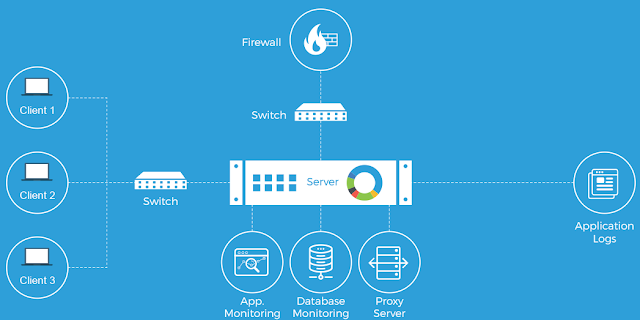Network Monitoring Solutions: Keeping Your Digital Ecosystem in Check
In today's fast-paced digital landscape, where the heartbeat of businesses and personal activities thrives on connectivity, the role of network monitoring solutions becomes increasingly vital. This article delves into the intricacies of network monitoring, exploring its definition, significance, and the key features that make it a linchpin for maintaining a healthy digital infrastructure.
Understanding Network Monitoring
A. Definition and Scope
Network monitoring, in essence, refers to the continuous surveillance of a computer network's performance, security, and overall health. It encompasses a range of tools and technologies designed to keep a watchful eye on the intricate web of interconnected devices and systems.
B. Why It Matters
The digital ecosystem is susceptible to various challenges like downtime, bottlenecks, and security threats. Network monitoring serves as a preemptive shield, providing real-time insights and alerts, thus mitigating potential risks and ensuring a seamless digital experience for users.
Key Features of a Network Monitoring Solution
A. Real-time Performance Tracking
One of the primary features of network monitoring solutions is their ability to provide real-time insights into the performance metrics of a network. Administrators can track bandwidth usage, identify latency issues, and ensure optimal performance across the entire network infrastructure.
B. Security Surveillance
Network monitoring solutions act as vigilant guardians, constantly scanning for potential security threats. By monitoring network traffic and identifying anomalies, these solutions play a crucial role in preventing and addressing security breaches before they escalate.
C. Scalability
As businesses and networks evolve, so do their needs. Network monitoring solutions are designed to scale with the growing demands of a network, ensuring that the monitoring process remains effective and comprehensive, regardless of the size of the digital infrastructure.
Types of Network Monitoring Solutions
A. Software-Based Solutions
Software-based network monitoring tools offer flexibility and ease of implementation. They are often customizable to suit specific network requirements, providing a cost-effective solution for businesses of varying sizes.
B. Hardware-Based Solutions
For more extensive and complex networks, hardware-based solutions offer robustness and reliability. These solutions often come in the form of dedicated appliances, providing a dedicated monitoring infrastructure for large-scale networks.
C. Cloud-Based Solutions
Cloud-based network monitoring solutions leverage the power of the cloud to deliver flexibility and accessibility. They allow administrators to monitor their networks from anywhere, offering a convenient and scalable solution for modern, distributed work environments.
How to Choose the Right Network Monitoring Solution
A. Assessing Your Network Needs
Before selecting a network monitoring solution, it's crucial to assess the specific needs of your network. Consider factors such as the size of the network, the complexity of the infrastructure, and the desired level of customization.
B. Compatibility and Integration
The chosen solution should seamlessly integrate with existing infrastructure and other tools in use. Compatibility ensures a smooth implementation process and reduces potential conflicts within the network.
C. User-Friendly Interface
An intuitive and user-friendly interface is essential for effective network monitoring. A solution with a well-designed interface simplifies the monitoring process, allowing administrators to identify and address issues promptly.
Network Monitoring Best Practices
A. Regular Audits and Updates
Regular audits and updates are paramount to the effectiveness of network monitoring. By conducting routine checks and staying updated on the latest developments, administrators can proactively identify and address potential issues before they impact network performance.
B. Alerts and Notifications
Automated alerts and notifications are a cornerstone of efficient network monitoring. These features ensure that administrators are promptly notified of any irregularities, allowing for swift action to prevent or minimize downtime.
C. Training and Skill Development
Investing in the training and skill development of IT teams is crucial. A well-trained team can harness the full potential of network monitoring tools, utilizing them to their maximum capacity and ensuring the network's optimal performance.
The Future of Network Monitoring
A. Artificial Intelligence Integration
The integration of Artificial Intelligence (AI) is transforming network monitoring. AI-powered solutions can analyze vast amounts of data, predict potential issues, and automate responses, leading to a more proactive and efficient network management approach.
B. IoT and Network Monitoring
The rise of the Internet of Things (IoT) introduces new complexities to network management. Advanced network monitoring solutions are evolving to seamlessly integrate with IoT devices, providing comprehensive oversight of the entire digital ecosystem.
Conclusion
In conclusion, a robust network monitoring solution is a cornerstone of a resilient digital infrastructure. From real-time performance tracking to proactive security surveillance, investing in the right network monitoring tools is an investment in the reliability and efficiency of your network.
Also Read:
Motadata Network Monitoring Software Solution
Network Monitoring Cloud?oring for Cloud: Is it Really Important for Cloud?



Comments
Post a Comment